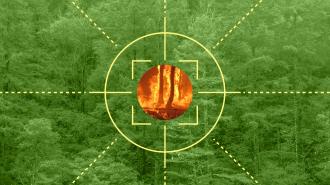As Canadian conflagrations painted the East Coast’s skies a shade which can only be described as “apocalyptic orange,” legislators in Colorado, a state more familiar with the threats of wildfire, were looking to join others across the West in using AI to snuff out the danger.
The plan would involve placing camera stations on mountaintops, with an AI monitoring the feed and flagging any signs of wildfire — like the system created by Pano AI.
“It can detect just a wisp of smoke and it’s that type of situation in remote areas that could save forests and homes and properties and lives,” Joann Ginal, a Democratic state senator in Colorado, said, per the AP.
States and cities across the wildfire-prone West are turning to AI to help fight the blaze.
It’s already happening in some parts of the state and across the region; there are already hundreds of cameras dotting the wilds of California, Nevada, and Oregon, the AP reported.
The AI-powered systems “allows us to take very aggressive early action and keep the impact down… not waiting until the end of the day to start playing catch-up,” Vaughn Jones, head of wildland fire prevention for Colorado’s Division of Fire Prevention and Control, told the AP.
Dryer woodlands — desiccated by droughts and worsened by climate change — are making fire season more extensive, as forests become kindling, increasing major wildfires. In response, multiple locations around the wildfire-prone West have begun working with Pano AI’s wildfire system.
Telluride, Colorado, and Spokane, Washington, announced agreements with Pano AI in March; Washington aplans on deploying Pano systems to various places across the state. Aspen has also inked an agreement, according to the AP, as has Pacific Gas & Electric (PG&E). The California utility’s aging power lines have been blamed for sparking several huge wildfires in recent years, resulting in billions of dollars in damages.
Pano’s Rapid Detect system is designed to detect, confirm, and then provide information for first responders about the wildfires.
According to the company’s site, Pano Stations placed on high vantage points continuously monitor the surrounding area using high definition, 360 degree cameras. The AI is trained on a set of over 300 million images to be able to determine what is smoke from a potential fire, chief commercial officer Arvind Satyam told the AP.
Pano AI’s Rapid Detect system is designed to detect, confirm, and then provide information for first responders about the wildfires.
When a potential wildfire is flagged, it gets sent to an intelligence center for human confirmation to ensure the risk is real. Once the fire is confirmed, information is piped to firefighters and first responders to paint a picture of the situation as it develops. That includes the fire’s exact location, which is often left to local engines to figure out, Satyam told Government Technology.
“It will give us a better idea of how to access the fire, which is critical to getting fire resources there faster,” Chief Nathan Jeffries of Spokane County Fire District 9 told local station KXLY.
“And if we have a fire that we just can’t control, that gets out of control and it’s potentially going to impact or hurt our firefighters, then we can look really quickly and figure out how to get them out faster too. So not only do we get there faster, but we can make it a safer environment for the firefighter to work in.”
We’d love to hear from you! If you have a comment about this article or if you have a tip for a future Freethink story, please email us at [email protected].






